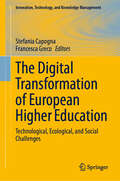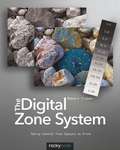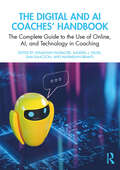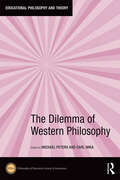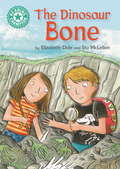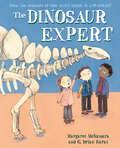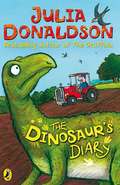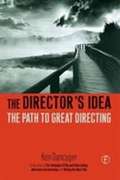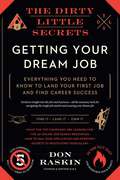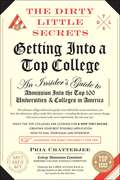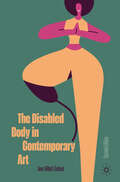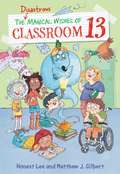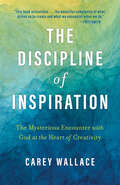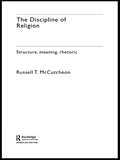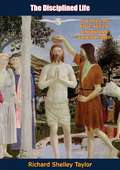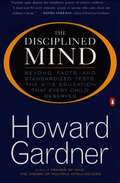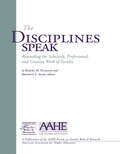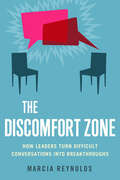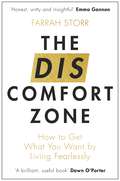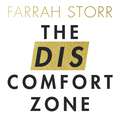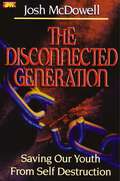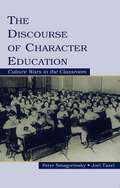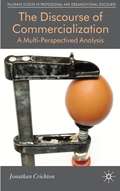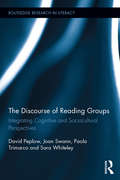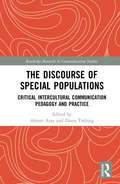- Table View
- List View
The Digital Transformation of European Higher Education: Technological, Ecological, and Social Challenges (Innovation, Technology, and Knowledge Management)
by Francesca Greco Stefania CapognaThis volume analyzes e-learning in European higher education, focusing on the technological, ecological, and social challenges of digital transformation. Started pre-pandemic and a result of an ECOLHE project funded by the European Union's Erasmus+ programme, the book discusses the impact of this global crisis, as well as the need for universities to integrate information and communications technology (ICT) in teaching and learning.The book presents multiple national case studies and examines how European universities adopt ICT for Lifelong Learning (LLL), uphold quality standards, and foster teachers' professional growth. It further sheds light on the translation of e-learning ideals into practical realities within academic institutions.From enhancing digital skills to refining teaching methodologies, the book offers valuable insights for educators, administrators, and policymakers alike. The multidisciplinary approach includes theoretical frameworks, pilot training initiatives, and strategic recommendations, all aimed at strengthening higher education's digital infrastructure. Navigating the challenges of digitalization, the book offers solutions for how European universities can remain resilient against the evolving demands of the modern world.
The Digital Zone System: Taking Control from Capture to Print
by Robert FisherThere is an ongoing debate among photographers whether digital photography processes will ever be able to reach the pinnacle of image quality and tonality achieved by Ansel Adams decades ago. The Digital Zone System (DZS) is an innovative methodology for editing digital images that mimics the Zone System created by Adams. With this book, author Robert Fisher presents a practical guide for editing digital images with a level of control previously unattainable without significant manual work. He walks the reader through the background of Adam's original Zone System and points out similarities to current digital processes including Expose to the Right (ETTR) and high dynamic range imaging (HDRI). Learn to use luminance masks to separate an image into "one-stop" zones of brightness, similar to the zones in Adams's Zone System, that can be worked on individually or in groups. This makes the DZS a powerful tool for converting color images to black and white. You will also gain tremendous control over how color is adjusted in your images by learning to isolate and adjust color in specific targeted areas. These DZS processes are quicker and simpler than the tedious work of using global adjustments and painting in layer masks to isolate the effects of an adjustment layer. In this book, you will learn how to use the Digital Zone System for editing color images, converting images to black and white, and tone mapping HDR images. Also included are brief discussions of color management, setting up Photoshop, printing, and exposure for digital images. The book is richly illustrated with step-by-step screenshots and stunning example images that show the benefits of the Digital Zone System over commonly used digital editing methods. Once mastered, the DZS will allow you to produce a higher level of quality in your images, at a faster pace and with greater ease than ever before.
The Digital and AI Coaches' Handbook: The Complete Guide to the Use of Online, AI, and Technology in Coaching (The Coaches' Handbook Series)
by Jonathan Passmore Sam Isaacson Sandra J. Diller Maximilian BrantlThis comprehensive practitioner guide supports coaches in developing their understanding of digital technologies and how to work in ever-changing digital environments, and shows coaches how to craft their own practices to take advantage of working online.The practice of coaching is undergoing significant change, with technology widely embedded and used in professional coaching services today. Coaching practitioners worldwide are adapting to digital environments, and a host of new technological tools have come into play, from the developments in virtual reality to AI-informed coaching, and from coaching bots to workplace apps. Edited by Jonathan Passmore, Sandra J. Diller, Sam Isaacson, and Maximilian Brantl, this third book in the acclaimed Coaches’ Handbook Series brings together internationally respected coaching experts and practitioners to share the most up-to-date know-how. The book takes you through key technical developments, the critical factors in making digital coaching successful, and how to build a coaching business using these technologies. The book also considers the impacts on the wider industry and concludes with a number of case studies of global coaching organisations and their experiences of using digital techniques, including CoachHub and EZRA.Aimed at coach practitioners, their supervisors, trainers, and student coaches on accreditation programmes or undertaking training for a certificate in coaching, this book showcases best practice, new ideas, and the science behind the digital revolution within coaching practice and the coaching industry.
The Dilemma of Western Philosophy (ISSN)
by Michael A. Peters Carl MikaThis edited collection takes a multifaceted approach to the various limitations and achievements of Western philosophy. Considered on its own, Western philosophy is a highly contentious name. The contributors question its validity as a label and take to task its grand appearance within education. However, part of the problem with Western philosophy is that it has less conventional as well as dominant manifestations. The writers consider both forms of Western philosophy, devoting significant thought and time to it in its own right, but always referring it to the more specific issue of education. This book adds to a growing corpus that sketches the relationship between education and philosophy, showing that they are deeply intertwined, and it is indeed philosophy (and especially its Western variation) that supports Western education and allows it to flourish in the first instance. It is fitting, then, that at various points this book depicts education as a hegemonic vehicle of a deeper phenomenon – that of dominant Western philosophy.This book was originally published as a special issue of Educational Philosophy and Theory.
The Dinosaur Bone: Independent Reading Turquoise 7 (Reading Champion #157)
by Elizabeth DaleRobbie is dinosaur mad! When Dad suggests the family go on a dinosaur bone hunt, Robbie and his sister Jen are on the case. Suddenly, they think they've found one ...Reading Champion offers independent reading books for children to practise and reinforce their developing reading skills.Fantastic, original stories are accompanied by engaging artwork and a reading activity. Each book has been carefully graded so that it can be matched to a child's reading ability, encouraging reading for pleasure.Independent Reading Turquoise 7 stories are perfect for children aged 5+ who are reading at book band 7 (Turquoise) in classroom reading lessons.
The Dinosaur Expert (Mr. Tiffin's Classroom Series)
by Margaret McNamaraJoin Mr. Tiffin and his students on a trip to a natural history museum and learn all about dinosaurs and the scientists who discovered them!Mr. Tiffin and his students are back in another picture book, and this time the focus is on dinosaur-loving Kimmy. During a field trip to the natural history museum, Kimmy is thrilled to share what she knows about the Stegosaurus and the Archaeopteryx and even the ginormous Titanosaurus. That changes when one of her classmates questions whether girls can be paleontologists. Kimmy starts to feel shy. What if they can't? What if no one wants to hear what she has to say? It will take some help from Mr. Tiffin--and from a famous scientist--for Kimmy to find her voice again.Join Mr. Tiffin's class as they learn about dinosaurs big and small, feathered and scaly, winged and ocean-dwelling. And root for Kimmy, the dinosaur expert . . . who might just learn something about herself.
The Dinosaur's Diary
by Julia DonaldsonAll fans of Julia Donaldson's should read the enchanting tale of The Dinosaur's Diary.Surviving and finding a safe place to lay her eggs is difficult for Hypsilophodon with dinosaurs like Tyrannosaurus Rex around. When she falls into a mysterious pool and finds herself on a modern farm there are still problems. Finally she finds a safe place to hatch her babies, but how can she keep thirteen baby dinosaurs safe and secret? When the farmer catches one - Hector - and plans to take him to the vet, it's up to Hypsilophodon and her fiesty daughter, Henrietta, to get him back. After a daring rescue, Hypsilophodon takes all her youngsters back through the mysterious pool to her own world.***A perfect read-aloud book for children age 7+******Julia Donaldson is one of today's most loved children's book authors***Julia Donaldson has a fast-growing reputation as a children's writer. She won the Smarties Prize and the Blue Peter Award for The Gruffalo, illustrated by Axel Scheffler. Since then, Julie and Axel have collaborated on a number of highly successful and award-winning picture books, including The Gruffalo's Child and Room on the Broom. Julia lives in Glasgow.'Donaldson's flair for a good story extends way up the age-scale' The Times'canters along, full of fun and energy' The ScotsmanVisit www.juliadonaldson.co.uk for
The Director’s Idea: The Path to Great Directing
by Ken Dancyger<i>The Director’s Idea</i> is a book that comes out of Ken Dancyger's teaching experience with production students at New York University and with professional producers and editors at the Maurits Binger Institute in Amsterdam. Provides an articulation of the storytelling tools of the director. This is a book about directing for directors and talented individuals who want to become directors.
The Dirty Little Secrets of Getting Your Dream Job
by Don RaskinDrawing on his extensive experience evaluating applicants for his marketing agency, and featuring stories based on real-life situations, sample cover letters, resumes, and straightforward advice, Don Raskin's The Dirty Little Secrets of Getting Your Dream Job offers all the necessary tools for navigating the tough job market and securing your dream job.Don Raskin owns and operates MME, an advertising and marketing agency in New York City. During his twenty-five years at the agency he has interviewed hundreds of new college graduates for positions within his agency and has placed a strong emphasis on entry-level recruitment for positions in creative, account management, traffic, and production. Raskin has also mentored countless students and their parents on best practices for the job search. Over the years, Raskin has kept exceptionally detailed notes on the interviews he has conducted, observing the good, the bad, the ridiculous, the irreverent. He also has a treasure trove of over-the-top cover letters, resumes, interviews, and post interview follow-ups he has conducted and received. Now, he wants to share all the wisdom and insider secrets he has gathered to help students and first-time job seekers find a job in this economy. Based on his remarkable expertise, Raskin's book provides exclusive insight into the job search process and lets readers in on all of the dirty little secrets to landing their first job--or a new one--and finding career success.
The Dirty Little Secrets of Getting into a Top College
by Pria ChatterjeeA top college admissions insider's exposes the never-before revealed secrets to getting into one of America's elite colleges.Your child is smart. Your child is on the honor roll. Your child aced the SAT. But is it enough to get into a top-tier college? In the Dirty Little Secrets of Getting into a Top College, educational consultant Pria Chatterjee simplifies the complicated process of college admissions, providing parents and students with the tools needed to secure a spot at one of America's most competitive colleges. In the spirit of Kitchen Confidential, Chatterjee gives readers an exclusive look inside the college admissions office--and the mind of a college admissions officer--and exposes just what elite schools look for in a potential student. Through a series of real-world case studies and with a store of deep insider knowledge, Chatterjee will help you navigate the thicket of college admissions and show parents and students what skills and attributes to stress (and what to downplay) when applying to your dream school. * 100% SUCCESS RATE: This is the bullet proof guide to getting into a top college from a consultant with a 100 percent success rate getting her clients into one of America's best universities.* INSIDER KNOWLEDGE: Last year 35,000 students applied to Harvard. Only 6 percent were accepted. Chatterjee, a Harvard alum who interviews potential Harvard students as a member of the university's schools committee, explains that you too can be a member of that elite group. But you must stress the right qualifications.<
The Disabled Body in Contemporary Art
by Ann Millett-GallantThe second edition offers an essential update to the foundational first edition, The Disabled Body in Contemporary Art. Featuring updated chapters and case studies, this second edition will not only expand on the first edition but will bring a new focus to contemporary disabled artists and their embodied, multimedia work.
The Disastrous Magical Wishes of Classroom 13 (Classroom 13 #2)
by Joelle Dreidemy Honest Lee Matthew J. GilbertFor fans of Captain Underpants or Sideways Stories from Wayside School, this new chapter book series is perfect for reluctant readers. When unlucky teacher Ms. Linda LaCrosse finds a magic lamp, she releases a genie--um, I mean, a Djinn--who agrees to grant each of her students ONE WISH!You might think this was fantastic, but it was not. It was a frightful idea! With magic wishes come hungry dinosaurs, stinky pizza, photographing paparazzi, and other huge mistakes. As the students of Classroom 13 are about to learn, you should be careful what you wish for. What would YOU do with one magic wish? The final chapter of each book encourages young readers to write their OWN chapter and send it in to the author, Honest Lee!The Disastrous Magical Wishes of Classroom 13 is the second title in a new chapter book series of hilarious stories about a very unlucky classroom. Each story is full of humor, action, and fun that will prompt hours of conversation among friends, families, and classrooms.(Psst! Hey you. Yeah, YOU! Just between us, this book also has a secret code hidden in every book that kids will have to figure out to read a chapter. Kids'll love it!) ©2017 by Hachette Book Group, Inc.
The Discipline of Inspiration: The Mysterious Encounter with God at the Heart of Creativity
by Carey WallaceLearn where inspiration comes from and how to harness it in your life and work. We all know the sensation of inspiration. It&’s what tells a painter what to paint and a singer how to sing—and what prompts us to throw a new spice into an old recipe. But what is inspiration? When we train artists, we typically identify them by their talent and train them in technique. We talk very little about the crucial creative spark of inspiration. Where does it come from? What does it want from us? How can we get more of it? In The Discipline of Inspiration, Carey Wallace meditates on this vital spark and on the ways artists have negotiated with it across genres and throughout history. She also offers practical methods—including silence, community, and rest—to help everyone access more inspiration, more often. Artists will develop a fresh perspective on inspiration and learn new tools for their creative practice. And readers from all walks of life will discover the transformative power of inspiration in every aspect of their lives.
The Discipline of Religion: Structure, Meaning, Rhetoric
by Russell T. McCutcheonThe Discipline of Religion is a lively critical journey through religious studies today, looking at its recent growth as an academic discipline, and its contemporary political and social meanings. Focusing on the differences between religious belief and academic religious discourse, Russell T. McCutcheon argues that the invention of religion as a discipline blurs the distinction between criticism and doctrine in its assertion of the relevance of faith as a credible object of study. In the leap from disciplinary criticism to avowal of actual cosmic and moral meaning, schools of religious studies extend their powers far beyond universities and into the everyday lives of those outside, managing and curtailing specific types of speech and dissent.
The Disciplined Life: Studies in Fine Art of Christian Discipleship
by Richard Shelley TaylorThe plight of modern man may be summed up in his striving for the road of self-indulgence. The way of least resistance is his goal.With bold, deft strokes from his ready pen, Dr. Richard S. Taylor penetrates the shallowness of our culture and lays bare the dire need for disciplined living.He touches on all those areas which stymie saints. Overeating, moodiness, erratic emotions, punctuality—all get their proper attention.But, best of all, he offers a program on how to actually become a disciplined person!If you are tired of the sloppiness and low productivity level of your personal life, wade in! This is the book for you!
The Disciplined Mind: Beyond Facts Standardized Tests K 12 Educ That Every Child Deserves
by Howard Gardner<P>Howard Gardner's concept of multiple intelligences has been hailed as perhaps the most profound insight into education since the work of Jerome Bruner, Jean Piaget, and, even earlier, John Dewey.<P> Now in The Disciplined Mind, Gardner pulls together the threads of his previous works in a major new synthesis aimed at parents, educators, and the general public alike.<P> The Disciplined Mind looks beyond such parochial issues as charters, vouchers, unions, and affirmative action in order to explore the larger questions of what an educated person should be and how such an education can be achieved for all students.<P> Gardner eloquently argues that the purpose of K-12 education should be to enhance students' deep understanding of truth (and falsity), beauty (and ugliness), and goodness (and evil) as defined by their various cultures. With this stance, Gardner transforms the tired debate between "traditionalists" and "progressives.".
The Disciplines Speak I: Rewarding the Scholarly, Professional, and Creative Work of Faculty
by Robert M. Diamond Bronwyn E. AdamThis set of two volumes offers statements from disciplinary/professional societies on what faculty work deserves recognition and reward in their unique culture/community. Volume I covers religion, history, geography, math, chemistry, the arts, business, journalism, and family/consumer science, plus the National Education Association.
The Discomfort Zone: How Leaders Turn Difficult Conversations Into Breakthroughs
by Marcia ReynoldsYou want people to stretch their limits, but your conversations meant to help them often fall flat or backfire, creating more resistance than growth. Top leadership coach Marcia Reynolds offers a model for using the Discomfort Zone—the moment when the mind is most open to learning—to prompt people to think through problems, see situations more strategically, and transcend their limitations. Drawing on recent discoveries in the neuroscience of learning, Reynolds shows how to ask the kinds of questions that short-circuit the brain&’s defense mechanisms and habitual thought patterns. Then, instead of being told, people see for themselves the insightful and often profound solutions to what is stopping their progress. The exercises and case studies will help you use discomfort in your conversations to create lasting changes and an enlivened workforce.
The Discomfort Zone: How to Get What You Want by Living Fearlessly
by Farrah Storr'Honest, witty and insightful' Emma Gannon'A brilliant, useful book' Dawn O'Porter'Farrah has written a book about the things no one wants to talk about: failure, discomfort, and how to deal with both' Sophia Amoruso, author of #GirlbossWhile it is human nature to shy away from things that are outside of our comfort zone, it is only by spending time in our discomfort zone that we can grow, and improve, and realise our full potential. Whether it's putting yourself forward for a new challenge, asking for difficult feedback, nailing a presentation or getting a dream job, in this book Farrah Storr shows how you have to push through what she calls "brief moments of discomfort" in order to get to where you need to be.Farrah describes these brief moments of discomfort as "like HIIT training for your life" - and shows how the more you force yourself into them, the easier it will get. This book is full of advice, practical exercises and examples both from Farrah's own life and career and from all sorts of other successful people, from athletes to entrepreneurs.By adopting the brief moments of discomfort, or BMD method, you will soon understand that nothing in life is an insurmountable challenge, only a series of small, uncomfortable tests that can easily be overcome. Once you have used Farrah's techniques to transform your fear into bite-size, manageable pieces, you'll be able to take on anything. In fact, in time, you'll even begin to enjoy these moments. When you explore your discomfort zone, you'll find that anything is possible.
The Discomfort Zone: How to Get What You Want by Living Fearlessly
by Farrah Storr'Honest, witty and insightful' Emma Gannon'A brilliant, useful book' Dawn O'Porter'Farrah has written a book about the things no one wants to talk about: failure, discomfort, and how to deal with both' Sophia Amoruso, author of #GirlbossWhen you explore your discomfort zone, you'll find that anything is possible.While it is human nature to shy away from things that are outside of our comfort zone, it is only by spending time in our discomfort zone that we can grow, and improve, and realise our full potential. Whether it's putting yourself forward for a new challenge, asking for difficult feedback, nailing a presentation or getting a dream job, in this book Farrah Storr shows how you have to push through what she calls "brief moments of discomfort" in order to get to where you need to be.Farrah describes these brief moments of discomfort as "like HIIT training for your life" - and shows how the more you force yourself into them, the easier it will get. This book is full of advice, practical exercises and examples both from Farrah's own life and career and from all sorts of other successful people, from athletes to entrepreneurs.By adopting the brief moments of discomfort, or BMD method, you will soon understand that nothing in life is an insurmountable challenge, only a series of small, uncomfortable tests that can easily be overcome. Once you have used Farrah's techniques to transform your fear into bite-size, manageable pieces, you'll be able to take on anything. In fact, in time, you'll even begin to enjoy these moments.
The Disconnected Generation
by Josh McdowellThe real battle is not in the amoral and immoral influences of our culture, but in the hearts of our young people, says author and speaker Josh McDowell inThe Disconnected Generation. And our young people are losing hope because they feel isolated and alienated from their parents. They are the disconnected generation. This book shows parents and youth workers how to understand and close the isolation gap to form nurturing, enduring relationships that can withstand cultural influences. As a companion toThe Disconnected Generation,the video curriculum resources provides five video sessions from Josh McDowell offering practical steps that every adult can take to close the emotional gap between themselves and their children.
The Discourse of Character Education: Culture Wars in the Classroom
by Peter Smagorinsky Joel TaxelIn this book Peter Smagorinsky and Joel Taxel analyze the ways in which the perennial issue of character education has been articulated in the United States, both historically and in the current character education movement that began in earnest in the 1990s. The goal is to uncover the ideological nature of different conceptions of character education. The authors show how the current discourses are a continuation of discourse streams through which character education and the national purpose have been debated for hundreds of years, most recently in what are known as the Culture Wars--the intense, often passionate debates about morality, culture, and values carried out by politicians, religious groups, social policy foundations, and a wide range of political commentators and citizens, in which the various stakeholders have sought influence over a wide range of social and economic issues, including education. The centerpiece is a discourse analysis of proposals funded by the United States Department of Education's Office of Educational Research and Improvement (OERI). Discourse profiles from sets of states that exhibit two distinct conceptions of character are examined and the documents from particular states are placed in dialogue with the OERI Request for Proposals. One profile reflects the dominant perspective promoted in the U.S., based on an authoritarian view in which young people are indoctrinated into the value system of presumably virtuous adults through didactic instruction. The other reflects the well-established yet currently marginal discourse emphasizing attention to the whole environment in which character is developed and enacted and in which reflection on morality, rather than didactic instruction in morality, is the primary instructional approach. By focusing on these two distinct regions and their conceptions of character, the authors situate the character education movement at the turn of the twenty-first century in the context of historical notions about the nature of character and regional conceptions regarding the nature of societal organization. This enlightening volume is relevant to scholars, practitioners, policymakers, and students across the field of education, particularly those involved in character education, moral development, discourse analysis, history and cultural foundations of education, and related fields, and to the wider public interested in character education.
The Discourse of Commercialization
by Jonathan CrichtonAn examination of how the commercialization of professional practice is implicated in its organizational discourses. Drawing on a study of ELT colleges, the book explores how teaching practices are permeated and challenged by a 'discourse of commercialization' through which market priorities become normative in teachers' professional lives.
The Discourse of Reading Groups: Integrating Cognitive and Sociocultural Perspectives (Routledge Research in Literacy)
by Joan Swann Sara Whiteley Paola Trimarco David PeplowOf interest in their own terms as a significant cultural practice, reading groups also provide a window on the everyday interpretation of literary texts. While reading is often considered a solitary process, reading groups constitute a form of social reading, where interpretations are produced and displayed in discourse. The Discourse of Reading Groups is a study of such joint conceptual activity, and how this is necessarily embedded in interpersonal activity and the production of reader identities. Uniquely in this context it draws on, and seeks to integrate, ideas from both cognitive and social linguistics. The book will be of interest to scholars in literacy studies as well as cultural and literary studies, the history of reading, applied linguistics and sociolinguistics, digital technologies and educational research.
The Discourse of Special Populations: Critical Intercultural Communication Pedagogy and Practice (Routledge Research in Communication Studies)
by Ahmet Atay Diana TrebingThe term "special population" occupies a particular purpose and has a particular role in the discourse of higher education. This book uses the term as an umbrella term for any student who tends to be underrepresented on college campuses and has a very specific set of unique needs: among others, individuals with physical and learning disabilities, international students, ethnic minorities, LGBTQ students, single parents, and first generation and other non-traditional student groups. Sometimes these "special" student groups are visible to educators; however, quite often they are hidden in plain sight, which makes it difficult for educators to work effectively and meaningfully with these student groups. This book uses the framework of critical intercultural communication pedagogy to generate a discussion about pedagogical issues surrounding students who are categorized as "special populations", focusing on culturally sensitive pedagogical methods to educate all students.
